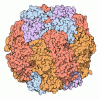[English] 日本語
 Yorodumi
Yorodumi- PDB-8io2: The Rubisco assembly intermidate of Arabidopsis thaliana Rubisco ... -
+ Open data
Open data
- Basic information
Basic information
| Entry | Database: PDB / ID: 8io2 | ||||||
|---|---|---|---|---|---|---|---|
| Title | The Rubisco assembly intermidate of Arabidopsis thaliana Rubisco accumulation factor 1 (AtRaf1) and Rubisco large subunit (RbcL) | ||||||
 Components Components |
| ||||||
 Keywords Keywords |  LYASE / Rubisco assembly intermediate / LYASE / Rubisco assembly intermediate /  CHAPERONE CHAPERONE | ||||||
| Function / homology |  Function and homology information Function and homology informationribulose bisphosphate carboxylase complex assembly /  photorespiration / photorespiration /  carboxysome / carboxysome /  ribulose-bisphosphate carboxylase / ribulose-bisphosphate carboxylase /  ribulose-bisphosphate carboxylase activity / reductive pentose-phosphate cycle / ribulose-bisphosphate carboxylase activity / reductive pentose-phosphate cycle /  chloroplast stroma / chloroplast stroma /  chloroplast / chloroplast /  monooxygenase activity / magnesium ion binding / monooxygenase activity / magnesium ion binding /  cytosol cytosolSimilarity search - Function | ||||||
| Biological species |  Synechococcus sp. (bacteria) Synechococcus sp. (bacteria)  Arabidopsis thaliana (thale cress) Arabidopsis thaliana (thale cress) | ||||||
| Method |  ELECTRON MICROSCOPY / ELECTRON MICROSCOPY /  single particle reconstruction / single particle reconstruction /  cryo EM / Resolution: 3.1 Å cryo EM / Resolution: 3.1 Å | ||||||
 Authors Authors | Wang, R. / Song, H. / Zhang, W. / Wang, N. / Zhang, S. / Shao, R. | ||||||
| Funding support |  China, 1items China, 1items
| ||||||
 Citation Citation |  Journal: Mol Plant / Year: 2023 Journal: Mol Plant / Year: 2023Title: Structural insights into the functions of Raf1 and Bsd2 in hexadecameric Rubisco assembly. Authors: Ran Wang / Hui Song / Wenjuan Zhang / Ning Wang / Shijia Zhang / Ruiqi Shao / Cuimin Liu /  Abstract: Hexadecameric form I Rubisco, which consisting consists of eight large (RbcL) and eight small (RbcS) subunits, is the most abundant enzyme on earth. Extensive efforts to engineer an improved Rubisco ...Hexadecameric form I Rubisco, which consisting consists of eight large (RbcL) and eight small (RbcS) subunits, is the most abundant enzyme on earth. Extensive efforts to engineer an improved Rubisco to speed up its catalytic efficiency and ultimately increase agricultural productivity. However, difficulties with correct folding and assembly in foreign hosts or in vitro have hampered the genetic manipulation of hexadecameric Rubisco. In this study, we reconstituted Synechococcus sp. PCC6301 Rubisco in vitro using the chaperonin system and assembly factors from cyanobacteria and Arabidopsis thaliana (At). Rubisco holoenzyme was produced in the presence of cyanobacterial Rubisco accumulation factor 1 (Raf1) alone or both AtRaf1 and bundle-sheath defective-2 (AtBsd2) from Arabidopsis. RbcL released from GroEL is assembly capable in the presence of ATP, and AtBsd2 functions downstream of AtRaf1. Cryo-EM structures of RbcL-AtRaf1, RbcL-AtRaf1-AtBsd2, and RbcL revealed that the interactions between RbcL and AtRaf1 are looser than those between prokaryotic RbcL and Raf1, with AtRaf1 tilting 7° farther away from RbcL. AtBsd2 stabilizes the flexible regions of RbcL, including the N and C termini, the 60s loop, and loop 6. Using these data, combined with previous findings, we propose the possible biogenesis pathways of prokaryotic and eukaryotic Rubisco. | ||||||
| History |
|
- Structure visualization
Structure visualization
| Structure viewer | Molecule:  Molmil Molmil Jmol/JSmol Jmol/JSmol |
|---|
- Downloads & links
Downloads & links
- Download
Download
| PDBx/mmCIF format |  8io2.cif.gz 8io2.cif.gz | 834.1 KB | Display |  PDBx/mmCIF format PDBx/mmCIF format |
|---|---|---|---|---|
| PDB format |  pdb8io2.ent.gz pdb8io2.ent.gz | 684.8 KB | Display |  PDB format PDB format |
| PDBx/mmJSON format |  8io2.json.gz 8io2.json.gz | Tree view |  PDBx/mmJSON format PDBx/mmJSON format | |
| Others |  Other downloads Other downloads |
-Validation report
| Arichive directory |  https://data.pdbj.org/pub/pdb/validation_reports/io/8io2 https://data.pdbj.org/pub/pdb/validation_reports/io/8io2 ftp://data.pdbj.org/pub/pdb/validation_reports/io/8io2 ftp://data.pdbj.org/pub/pdb/validation_reports/io/8io2 | HTTPS FTP |
|---|
-Related structure data
| Related structure data |  35605MC 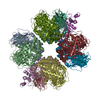 8ilbC 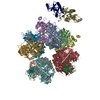 8ilmC 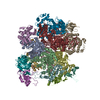 8iojC 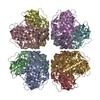 8iolC M: map data used to model this data C: citing same article ( |
|---|---|
| Similar structure data | Similarity search - Function & homology  F&H Search F&H Search |
- Links
Links
- Assembly
Assembly
| Deposited unit | 
|
|---|---|
| 1 |
|
- Components
Components
| #1: Protein | Mass: 52385.410 Da / Num. of mol.: 8 Source method: isolated from a genetically manipulated source Source: (gene. exp.)   Synechococcus sp. (strain ATCC 27144 / PCC 6301 / SAUG 1402/1) (bacteria) Synechococcus sp. (strain ATCC 27144 / PCC 6301 / SAUG 1402/1) (bacteria)Strain: ATCC 27144 / PCC 6301 / SAUG 1402/1 / Gene: cbbL, rbcA, rbcL, syc0130_c / Production host:   Escherichia coli BL21(DE3) (bacteria) Escherichia coli BL21(DE3) (bacteria)References: UniProt: P00880,  ribulose-bisphosphate carboxylase ribulose-bisphosphate carboxylase#2: Protein | Mass: 38436.730 Da / Num. of mol.: 9 Source method: isolated from a genetically manipulated source Source: (gene. exp.)   Arabidopsis thaliana (thale cress) / Gene: RAF1.2, At3g04550, F7O18.2 / Production host: Arabidopsis thaliana (thale cress) / Gene: RAF1.2, At3g04550, F7O18.2 / Production host:   Escherichia coli BL21(DE3) (bacteria) / References: UniProt: Q9SR19 Escherichia coli BL21(DE3) (bacteria) / References: UniProt: Q9SR19 |
|---|
-Experimental details
-Experiment
| Experiment | Method:  ELECTRON MICROSCOPY ELECTRON MICROSCOPY |
|---|---|
| EM experiment | Aggregation state: PARTICLE / 3D reconstruction method:  single particle reconstruction single particle reconstruction |
- Sample preparation
Sample preparation
| Component | Name: the complex of RbcL and Raf1 (L8F8) / Type: COMPLEX / Entity ID: all / Source: MULTIPLE SOURCES |
|---|---|
| Source (natural) | Organism:   Arabidopsis thaliana (thale cress) Arabidopsis thaliana (thale cress) |
| Source (recombinant) | Organism:   Escherichia coli BL21(DE3) (bacteria) Escherichia coli BL21(DE3) (bacteria) |
| Buffer solution | pH: 8 |
| Specimen | Embedding applied: NO / Shadowing applied: NO / Staining applied : NO / Vitrification applied : NO / Vitrification applied : YES : YES |
Vitrification | Cryogen name: ETHANE |
- Electron microscopy imaging
Electron microscopy imaging
| Experimental equipment |  Model: Titan Krios / Image courtesy: FEI Company |
|---|---|
| Microscopy | Model: FEI TITAN KRIOS |
| Electron gun | Electron source : :  FIELD EMISSION GUN / Accelerating voltage: 300 kV / Illumination mode: FLOOD BEAM FIELD EMISSION GUN / Accelerating voltage: 300 kV / Illumination mode: FLOOD BEAM |
| Electron lens | Mode: BRIGHT FIELD Bright-field microscopy / Nominal defocus max: 2500 nm / Nominal defocus min: 1500 nm Bright-field microscopy / Nominal defocus max: 2500 nm / Nominal defocus min: 1500 nm |
| Image recording | Electron dose: 40 e/Å2 / Film or detector model: GATAN K2 SUMMIT (4k x 4k) |
- Processing
Processing
CTF correction | Type: PHASE FLIPPING AND AMPLITUDE CORRECTION |
|---|---|
3D reconstruction | Resolution: 3.1 Å / Resolution method: FSC 0.143 CUT-OFF / Num. of particles: 535498 / Symmetry type: POINT |
 Movie
Movie Controller
Controller






 PDBj
PDBj